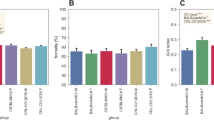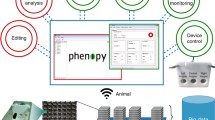Abstract
The behaviour of rats placed in a new environment was determined simultaneously by photocells and by direct observation. Predictably, a typical photocell activity cage did not measure a simple or homogeneous pattern of behaviour even in undrugged animals: two components of behaviour, the number of walks across the cage and of rears onto the hind feet, were correlated with photocell counts, but grooming was not. Even this agreement between observation and automation broke down if dexamphetamine was given; the correlation between rears and photocell counts was reduced by graded doses of dexamphetamine and by dexamphetamine-amylobarbitone mixtures, and the stimulant effect of dexamphetamine on walks was greatly exaggerated by the photocells. Such discrepancies were much smaller with amylobarbitone alone. For the testing of drugs, the use of activity cages seems to be more limited than has sometimes been supposed. Complex changes of behaviour are masked by the relatively crude photocell counts, but they may be detected by standardised observation. Watching the animals might also help with the development of improved automatic devices.
Similar content being viewed by others
References
Berlyne, D. E.: The arousal and satiation of perceptual curiosity in the rat. J. comp. physiol. Psychol. 48, 238–246 (1955).
Bindra, D., Baran, D.: Effects of methylphenidylacetate and chlorpromazine on certain components of general activity. J. exp. Anal. Behav. 2, 343–350 (1959).
Bradley, D. W. M., Joyce, D., Murphy, E. H., Nash, B. M., Porsolt, R. D., Summerfield, A., Twyman, W. A.: Amphetamine-barbiturate mixture: effects on the behaviour of mice. Nature (Lond.) 220, 187–188 (1968).
Brown, B.: CNS drug actions and interactions in mice. Arch. int. Pharmacodyn. 128, 391–414 (1960).
Chance, M. R. A.: Aggregation as a factor influencing the toxicity of sympathomimetic amines in mice. J. Pharmacol. exp. Ther. 87, 214–219 (1946).
— Ethology and psychopharmacology. Psychopharmacology: Dimensions and Perspectives, pp. 283–318. Joyce, C. R. B. (Ed.) London: Tavistock Publications 1968.
—, Silverman, A. P.: The structure of social behaviour and drug action. Animal Behaviour and Drug Action, pp. 65–79. Steinberg, H., A. V. S. de Reuck, and J. Knight (Eds). London: Churchill 1964.
Cofer, C. N., Appley, M. H.: Motivation: Theory and Research, pp. 269–301. London: Wiley 1964.
Cook, L., Weidley, E. F., Morris, R. W., Mattis, P. A.: Neuropharmacological and behavioural effects of chlorpromazine (thorazine hydrochloride). J. Pharmacol. exp. Ther. 113, 11 (1955).
Dews, P. B.: The measurement of the influence of drugs on voluntary activity of mice. Brit. J. Pharmacol. 8, 46–48 (1953).
Eayrs, J. T.: Spontaneous activity in the rat. Brit. J. Anim. Behav. 2, 25–30 (1954).
Finger, F. W.: Estrus and general activity in the rat. J. comp. physiol. Psychol. 68, 461–466 (1969).
Gross, C. G.: General activity. Analysis of Behavioral Change, pp. 89–106, Weiskrantz, L., (Ed.). London: Harper & Row 1968.
Heimstra, N. W.: Social influence on the response to drugs: I. Amphetamine sulphate. J. Psychol. 53, 233–244 (1962).
Irwin, S.: Comprehensive observational assessment: 1A. A systematic quantitative procedure for assessing the behavioral and physiologic state of the mouse. Psychopharmacologia (Berl.) 13, 222–257 (1968).
Janků, I., Kršiak, M.: Proc. Europ. Soc. for the Study of drug Toxicity, 8, 86–92. Excerpta Medica International Congress No. 118 (1966).
Kinnard, W. J., Carr, C. J.: A preliminary procedure for the evaluation of central nervous system depressants. J. Pharmacol. exp. Ther. 121, 354–361 (1961).
— Watzman, N.: Techniques utilised in the evaluation of psychotropic drugs on animal activity. J. Pharm. Sci. 55, 995–1012 (1966).
Kršiak, M., Steinberg, H., Stolerman, I. P.: Discrepancies in results obtained with activity cages and by observation. Brit. J. Pharmacol. 34, 684P-685P (1968).
Kumar, R.: Psychoactive drugs, exploratory activity and fear. Nature (Lond.) 218, 665–667 (1968).
—: Exploration and latent learning: differential effects of dexamphetamine on components of exploratory behaviour in rats. Psychopharmacologia (Berl.) 16, 54–72 (1969).
Lát, J.: The spontaneous exploratory reactions as a tool for psychopharmacological studies. A contribution towards a theory of contradictory results in psychopharmacology. Pharmacology of Conditioning, Learning and Retention. Mikhel'son, M. Ya., and V. G. Longo (Eds). London: Pergamon 1964.
Miller, N. E.: The analysis of motivational effects illustrated by experiments on amylobarbitone. Animal Behaviour and Drug Action, pp. 1–18. Steinberg, H., A. V. S. de Reuck, and J. Knight (Eds). London: Churchill 1964.
Morrison, C. F., Lee, P. N.: A comparison of the effects of nicotine and physostigmine on a measure of activity in the rat. Psychopharmacologia (Berl.) 13, 210–221 (1968).
Randrup, A., Munkvad, I., Udsen, P.: Adrenergic mechanisms and amphetamine induced abnormal behaviour. Acta pharmacol. (Kbh.) 20, 145–157 (1963).
Read, G. W., Cutting, W., Fürst, A.: Comparison of excited phases after sedatives and tranquilizer. Psychopharmacologia (Berl.) 1, 346–350 (1960).
Rushton, R., Steinberg, H.: Mutual potentiation of amphetamine and amylobarbitone measured by activity in rats. Brit. J. Pharmacol. 21, 295–305 (1963).
— Drug combinations and their analysis by means of exploratory activity in rats. Neuropsychopharmacology, pp. 464–470. H. Brill, J. O. Cole, P. Deniker, H. Hippius, P. B. Bradley (Eds). Amsterdam: Excerpta Medica 1967.
Russell, R. W.: An approach to the development of animal screening techniques in psychopharmacology. U.S. Public Health Service Psychopharmacology Service Center Bulletin, 1–7 (December, 1960).
Rutledge, C. O., Kelleher, R. T.: Interactions between the effects of methamphetamine and pentobarbital on operant behavior in the pigeon. Psychopharmacologia (Berl.) 7, 400–408 (1965).
Siegel, P. S., Steinberg, M.: Activity level as a function of hunger. J. comp. physiol. Psychol. 42, 413–416 (1949).
Silverman, A. P.: Ethological and statistical analysis of drug effects on the social behaviour of laboratory rats. Brit. J. Pharmacol. 24, 579–590 (1965).
Snedecor, G. W., Cochran, W. G.: Statistical methods, 6th Edtn. Ames (Iowa): The Iowa State University Press 1967.
Steinberg, H.: Experimental methods in psychopharmacology. pp. 78–87. Recent Advances in Pharmacology. Robson, J. M., and R. S. Stacy (Eds). London: Churchill 1962.
Tainter, M. L.: Effects of certain analeptic drugs on spontaneous running activity of the white rat. J. comp. Psychol. 36, 143–155 (1943).
Tapp, J. T., Zimmerman, R. S., D'Encarnacao, P. S.: Intercorrelational analysis of some common measures of rat activity. Psychol. Rep. 23, 1047–1050 (1968).
Tedeschi, D. M., Fowler, P. J., Cromley, W. H., Pauls, J. F., Eby, R. Z., Fellows, E. J.: Effects of centrally acting drugs on confinement motor activity. J. Pharm. Sci. 53, 1046–1050 (1964).
Svensson, T. H., Thieme, G.: An investigation of a new instrument to measure motor activity of small animals. Psychopharmacologia (Berl.) 14, 157–163 (1969).
Watzman, N., Barry, M., Kinnard, W. J., Buckley, J. P.: Comparison of different photobeam arrangements for measuring spontaneous activity of mice. J. Pharm. Sci. 55, 907–909 (1966).
Weiss, B., Laties, V. G.: Effects of amphetamine, chlorpromazine, pentobarbital, and ethanol on operant response duration. J. Pharmacol. exp. Ther. 144, 17–23 (1964).
Winter, C. A., Flataker, L.: The effect of cortisone, desoxycorticosterone, and adrenocorticotrophic hormone upon the response of animals to analgesic drugs. J. Pharmacol. exp. Ther. 103, 93–105 (1951).
Author information
Authors and Affiliations
Rights and permissions
About this article
Cite this article
Kršiak, M., Steinberg, H. & Stolerman, I.P. Uses and limitations of photocell activity cages for assessing effects of drugs. Psychopharmacologia 17, 258–274 (1970). https://doi.org/10.1007/BF00402085
Received:
Issue Date:
DOI: https://doi.org/10.1007/BF00402085




